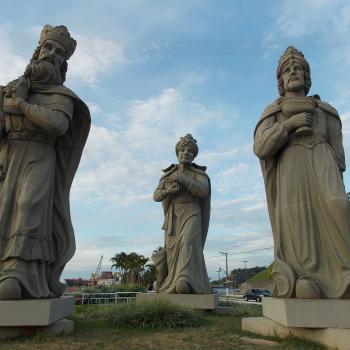In our last post, we met some actual characters in the dialogue. Let’s all step back just a moment and widen our lens so we can get a panoramic view. While the Nicene Creed is the heart of our story, the provoking cause of its writing, the actual Council members who wrote it and the decades that followed are all a package. That is, it’s not a tidy tale of a theological conflagration that erupted and its orderly resolution. In fact, though the Creed was drafted in 325 and edited into its final version by 381, the Church argued about its meaning and implications for decades before and after the Council.
So our story is a before/during/after review of the Council of Nicea and its integration into the life and language of the Church. Would that Church history were more orderly, but no.
Some find the messiness and arm-wrestling evidence that the church leaders had lost the favor and intention of God. This is a common Mormon perception—that after the apostles, the early church leaders stumbled and lost touch with God’s revelation. Mormons call this the time of the apostasy, a time when the church lost the truth and concocted bizarre ideas like, well, like the Trinity. Ergo, they teach that the Father, the Son, and the Holy Ghost are three separate divine beings. Muhammad, too, found that Trinitarian ideas were not only incomprehensible, but offensive. For Muslims, the absolute simplicity of God is the single most vital truth about God’s nature, and the idea of Jesus as his offspring is ludicrously complicated. And therefore patently untrue.
We who call ourselves Christians can look baldly at the sometimes vitriolic theological controversies; we don’t need to deny them or cover them up and pretend they were all nicey-nicey church board meetings. (Wait. Are there such things?) We can simultaneously regret bad behavior and embrace the power of the Spirit in leading us into all truth. These were big issues, big conversations, and they involved big personalities. Most importantly, they were all working under the premise that something real and profoundly new had happened in the world and that God had revealed his One true self as a Father sending, a Son redeeming, a Spirit infusing. We do not let go of the Oneness; we cannot forget the Threeness.
So we go on, deeper into the mystery in the company of our ancestors in faith.
As good historians, one of the things we have to look at is the context of the conversation. We’ve already recognized the political shift that Constantine initiated, but the 4th-century world was highly complex in many ways. As Christian thinkers and leaders were trying to articulate the faith, they were doing so in an arena rife with all kinds of shifting currents.
One key to understanding the sometimes heated conversation is to recognize that as the Empire gradually shifted its center of gravity from Rome to Constantinople, the differences between the Greek East and the Latin West grew with remarkable speed. This was accelerated by the ongoing military ventures in both arenas—in the East, against the Sassanid Persian Empire; in the West, against the “barbarian hordes.” Lines of communication, travel, commerce, and the administrative unity of the Church all weakened. Language became problematic. While the capital was Rome, Latin had been the official language, but when the capital was moved to Byzantium, Greek became the primary language of state and church.
Greek and Latin are very different animals. In general, Greek is more evocative and fluid whereas Latin is more precise and juridical. Greek terms can be more speculative and multidimensional, whereas Latin terms are more exact and clear cut. Philip Jenkins’ book, The Jesus Wars, spells out the problems that linguistics created. The Greek terms we looked at (in Part 1) created confusion. We said that the theologians used the word ousia to describe God’s One Being, Essence, and the word hypostases to describe the three “existences.” The Greek work hypostasis would be translated into Latin as substantia, so whereas in Greek we’re thinking of three “expressions” of God’s one being, the Latin substantia would make three “substances.” Which sounds a lot like three different beings. The Latins wanted to use the word persona, but in Greek that would be prosopon, which implied a role, a persona or character like an actor in a play.
Another of the key terms of the Nicene discussion was homoousios. It means “identical or same substance.” You find it there in the line of the Creed that says: “We believe in one Lord, Jesus Christ … of one Being with the Father.” Just a few months ago, the Roman Catholic Church returned to a more archaic term to express this: “consubstantial with the Father.” Many early church thinkers wanted to use another term—homoiousios. The difference? Besides that innocent little ‘i’ in the middle of the word? That Greek letter, iota, changed the meaning considerably. Instead of being same substance, it then meant similar substance. If those theologians had won, we would have been saying: “We believe in one Lord … who is a whole lot like the Father.”
In general, we can say that these linguistic differences led to suspicions. (What? Distrust in the church? Say it isn’t so.) Many in the East felt that Latin Christians so fixated on the same substance issue that they snuck in Sabellian (modalist) ideas; that is, they suspected that the Latins watered down the real distinctions of the Threeness of God to the point that threeness was nothing more than phases of divine existence. On the other hand, many Latins thought that the Greeks overemphasized the hypostases, the threeness of God, to the point that they began to sound like tritheists or perhaps Arians.
Back and forth. Around and around. The Latin theologian Jerome complained to Pope Damasus that it should be three personae, not hypostases, which made him feel like there were three distinct essences, losing the unity of God. The Greek theologian Basil resisted personae, which would be like describing three roles or manifestations, and thus lead to modalist ideas. Basil actually put forward the culminating distinction; let’s, he said, use two terms: ousia and hypostases to describe one essence and three existences.
All this because of differences in language. Just imagine the consequences if they’d had instant messaging and emoticons. Would Jerome have felt better if Basil had just written: “It’s hypostases!” ![]()
Words matter. Language, as limiting as it is, is all we have to work with. Yes, it’s inadequate, but it is also the material by which we name our memories and share them with each other.
Next week we’ll look at the way Anatolios explains the flow of Christian memory and experience that was abruptly interrupted by new currents in the conversation. In other words, why Arius? We’ve said heretics are trying to solve problems that the Church has not yet faced – so what new problem did Arius recognize?
Note to Reader: This series on Trinitarian Spirituality explores the history and spirituality behind the shaping of the Nicene Creed using Khaled Anatolios’ Retrieving Nicaea: The Development and Meaning of Trinitarian Doctrine (Grand Rapids, MI: Baker Academic, 2011) as guide and inspiration. It’s best to begin at the beginning: An Introduction.












